Thisispage�
Printer:Opaquethis
TheSpikeResponseModel
WulframGerstner
�
Thisispage�
Printer:Opaquethis
MNN�
September� ,�
�
�
�.TheSpikeResponseModel
ABSTRACTAdescriptionofneuronalactivityonthelevelofionchannels,
asintheHodgkin-Huxleymodel,leadstoasetofcouplednonlineardier-
entialequationswhicharediculttoanalyze.Inthispaper,wepresenta
conceptualframeworkforareductionofthenonlinearspikedynamicsto
athresholdprocess.Spikesoccurifthemembranepotentialu(t)reachesa
threshold#.Thevoltageresponsetospikeinputisdescribedbythepostsy-
napticpotential.Postsynapticpotentialsofseveralinputspikesareadded
linearlyuntilureaches#.Theoutputpulseitselfandthereset/refractory
periodwhichfollowthepulsearedescribedbyafunction.Sinceand
canbeinterpretedasresponsekernels,theresultingmodeliscalledthe
SpikeResponseModel(SRM).AfterashortreviewoftheHodgkin-Huxley
modelweshowthat(i)Hodgkin-Huxleydynamicswithtime-dependent
inputcanbereproducedtoahighdegreeofaccuracybytheSRM;(ii)
thesimpleintegrate-and-reneuronisaspecialcaseoftheSpikeResponse
Model;(iii)compartmentalneuronswithapassivedendritictreeanda
thresholdprocessforspikegenerationcanbetreatedinSRM-framework;
(iv)smallnonlinearitiesleadtointeractionsbetweenspikestobedescribed
byhigher-orderkernels.
� Introduction
Thesuccessfulmathematicaldescriptionofactionpotentialsinthegiant
axonofthesquidbyHodgkinandHuxleyin� ��hasleadtoawhole
seriesofmodelingpaperswhichtrytodescribeindetailthedynamicsof
variousionchannelsonthesomaanddendritesduringspikereceptionand
spikeemission.Withmoderncomputersitisnowpossibletonumerically
integratemodelswith��to��typesofionchannelandhundredsofspa-
tialcompartments[YKA� ,TWMM �,BB �]andreproduceexperimental
ndingstoahighdegreeofaccuracy.Ontheotherhand,itisoftendi-
culttograspintuitivelytheessentialphenomenaofneuronaldynamicsfrom
thesemodels.Inparticular,itisoutofreachtounderstandthesemodels
analytically.Moreover,inanetworksettingthequestionariseswhetherall
thedetailsdescribedincompartmentalmodelsarenecessarytounderstand
thecomputationinlargepopulationsofneurons.
Forananalyticalunderstandingofnetworksofspikingneurons,asimpli-
eddescriptionofneuronaldynamicsisthereforedesirable[AK �,Abb �].
Forthisreasonintegrate-and-remodels[Lap��,Ste��,Tuc��]havebe-
comeincreasinglypopularfortheinvestigationofprinciplesofcortical
dynamicsandfunction,e.g.,[MS �,AvV �,Tre �,SNS �,BH ].The
reductionofdetailedneuronmodelstoastandardintegrate-and-reunit
requiressimplicationsinatleasttworespects.First,thenonlineardynam-
icsofspikegeneration[HH��,RE� ]mustbereducedtoaleakyintegrator
withthresholdring[AK �].Second,eectsofthespatialstructureofthe
neuron[Ral��,Tuc��,AFG �,BT �]mustbereducedtosomeeective
input[Abb �].
�
�.TheSpikeResponseModel
�
Inthispaperweaddressbothissuesfromthesystematicpointofviewofa
responsekernelexpansion.ItisshownthatspikegenerationintheHodgkin-
Huxleymodelcanbereproducedtoahighdegreeofaccuracybyasingle-
variablethresholdmodel[KGvH �].Theproblemofspatialstructureis
studiedforamulti-compartmentalintegrate-and-remodelwithapassive
dendritictree[AFG �,BT �]andactivecurrentsatthesoma.Inthiscase,
themodeldynamicscanbesolvedandsystematicallyreducedtoasingle-
variablemodelwithresponsekernels.
Afterthereductionoftheintricateneuronaldynamicstoathreshold
model,itisthenpossibletostudyanalyticallythedynamicsofnetworks
ofneurons.Ithasbeenshownpreviouslythatinalargenetworkofmodel
neuronswithhomogeneouscouplings,thestabilityofcoherent,incoherent,
orpartiallycoherentstatescanbeunderstoodinatransparentmanner
[AvV �,GvH �,Ger �,GvHC �,BH ].Moreover,thecollectiveresponse
ofapopulationofspikingneuronstoacommontime-dependentinputcan
beanalyzed[Ger��].Themathematicalconsiderationsthatarenecessary
forareductionofthehighlynonlinearHodgkin-Huxleyequationstoa
single-variablethresholdmodelarethereforeworththeeort.
Thechapterisorganizedasfollows.Westartinsection�withareview
ofthestandardHodkgin-Huxleymodel.Thefourdierentialequationsof
HodgkinandHuxleygiveanaccuratedescriptionofneuronalspikinginthe
giantaxonofthesquid.Thedrawbackisthattheyarehighlynon-linear
andthereforediculttoanalyzemathematically.Wethereforeaimfora
simplerphenomenologicaldescription.Themethodweproposeisbasedon
spikeresponsekernelsandprovidesabiologicallytransparentdescription
oftheessentialeectsduringspiking.Inthesecondpartofsection�,we
willseethattheSpikeResponseModel(SRM),derivedfromtheHodgkin-
HuxleymodelbytheSpikeResponseMethod,canreproduceupto �
percentofthespiketimesoftheHodkgin-Huxleymodelcorrectly.
AshortsummaryofthemathematicsoftheSpikeResponseModelis
presentedinsection�.Anotherwell-knownmodelofneuronalspikingisthe
integrate-and-remodelwhichisreviewedinsection�.Weshowthatthe
integrate-and-reisinfactofspecialcaseoftheSpikeResponseModel.The
mappingfromtheintegrate-and-remodeltotheSpikeResponseModelis
discussedinsomedetailinsections�.�.and�.�.Insection�weaddressthe
questionofspatialstructure.Weshowthatinthecaseofalineardendritic
treethedynamicscanbewellcapturedbyspikeresponsekernels.Finally
insection�wediscussweaklynon-lineareects.Throughoutthetext,the
generalargumentsareinteruptedbyexamplesintendedtoillustratethe
mainresults.
�
-
+
C
R
K
I
Na
-
+
+
-
+
Na
outside
K
Cl
inside
-
�.TheSpikeResponseModel
�
FIGURE�.SchematicdiagramfortheHodgkin-Huxleymodel.Takenfrom
[Ger �].
� Hodgkin-Huxleymodel
TheclassicdescriptionofneuronalspikingdatesbacktoHodgkinand
Huxley[HH��]whosummarizedtheirextensiveexperimentalstudieson
thegiantaxonofthesquidwithfourdierentialequations.Arstand
fundamentalequationdescribestheconservationofelectriccurrents.Then
therearethreefurtherdierentialequationswhichdescribethedynamicsof
sodiumandpotassiumionchannels.Modernmodelsofneuronaldynamics
makeuseofthesametypeofequations,butofteninvolvemanymore
dierentionchanneltypes.Theionchannelsmaybelocatedondierent
compartmentsofaspatiallyextendedneuronmodel.Asingleneuronmay
thenbedescribedbyhundredsofcouplednon-lineardierentialequations.
InthissectionwesticktothestandardHodgkin-Huxleymodelwithout
spatialstructureanduseitasareferencemodeltostudythedynamics
ofspikegeneration.IntherstsubsectionwereviewtheHodgkin-Huxley
equations.Inthesecondsubsectionwereducethenonlineardynamicsof
theHodgkin-Huxleymodeltoathresholdmodelwithasinglevariable
u(t).ThisreductionwillbethebasisforadiscussionoftheSpikeResponse
ModelinSections�-�.
�.�Denitionofthemodel
TheHodgkin-HuxleymodelcanbeunderstoodwiththehelpofFig.�.
Thesemipermeablecellmembraneseparatestheinteriorofthecellfrom
theextracellularliquid.Duetothemembrane'sselectivepermeabilityand
alsobecauseofactiveiontransportthroughthecellmembrane,theion
concentrationinsidethecellisdierentfromtheoneintheextracellular
liquid.Thedierenceinconcentrationgeneratesanelectricalpotentialbe-
tweentheinteriorandtheexteriorofthecell.Thecellmembraneactslike
acapacitorwhichhasbeenchargedbyabattery.IfaninputcurrentI(t)
isinjectedintothecell,itmayaddfurtherchargeonthecapacitor,orleak
throughthechannelsinthecellmembrane.
�
1.0
m
n
-50.0
10.0
5.0
h
m
-50.0
0.0
50.0
100.0
50.0
100.0
h
n
0.0
u [mV]
)
u
(
0
x
0.5
]
s
m
[
)
u
(
τ
u [mV]
0.0
-100.0
0.0
-100.0
�.TheSpikeResponseModel
�
a)
b)
FIGURE�.Equilibriumfunction(a)andtimeconstant(b)forthethreevari-
ablesm;n;hintheHodgkin-Huxleymodel.Takenfrom[Ger �].
Letusnowtranslatetheaboveconsiderationsintomathematicalequa-
tions.Theconservationofelectricchargeonapieceofmembraneimplies
thattheappliedcurrentI(t)maybesplitinacapacitivecurrentICwhich
chargesthecapacitorCandfurthercomponentsIkwhichdiusethrough
theionchannels.Thus
I(t)=IC+XkIk
(�.�)
wherethesumrunsoverallionchannels.InthestandardHodgkin-Huxley
modelthereareonlythreetypesofchannel:asodiumchannelwithindex
Na,apotassiumchannelwithindexKandanunspecicleakagechannel
withresistanceR;cf.Fig.�.FromthedenitionofacapacityC=Q=u
whereQisachargeanduthevoltageacrossthecapacitor,wendthe
chargingcurrentIC=Cdu=dt.Hencefrom(�.�)
Cdudt=XkIk+I(t):
(�.�)
Inbiologicalterms,uisthevoltageacrossthemembraneandPkIkisthe
sumoftheioniccurrentswhichpassthroughthecellmembrane.
Asmentionedabove,theHodgkin-Huxleydescribesthreetypesofchan-
nel.Allchannelsmaybecharacterizedbytheirresistanceor,equivalently,
bytheconductance.Theleakagechannelisdescribedbyavoltage-inde-
pendentconductancegL=�=R;theconductanceoftheotherionchannels
isvoltagedependent.Ifthechannelsarefullyopen,theytransmitcurrents
withamaximumconductancegNaorgK,respectively.Normally,however,
thechannelsarepartiallyblocked.Theremovaloftheblockisvoltagede-
pendentandisdescribedbyadditionalvariablesm;n,andh.Thecombined
actionofmandhcontrolstheNachannels.TheKgatesarecontrolledbyn.
Specically,HodgkinandHuxleyformulatedthethreecurrentcomponents
as XkIk=gNam�h(uVNa)+gKn�(uVK)+gL(uVL):
(�.�)
TheparametersVNa,VK,andVLarecalledreversalpotentialssincethe
�
�.TheSpikeResponseModel
�
x
ux
gx
���mV ���mS/cm�
Na
��mS/cm�
K
-��mV
��.�mV �.�mS/cm�
L
x
x(u=mV)
x(u=mV)
(�:��:��u)=[exp(��:�u)�]
n
�:���exp(u=��)
m(�:��:�u)=[exp(�:��:�u)�]
�exp(u=��)
�:��exp(u=��)
h
�=[exp(��:�u)+�]
TABLE�.�.TheparametersoftheHodgkin-Huxleyequations.Themembrane
capacityisC=�F/cm�.
directionofacurrentIkchangeswhenucrossesVk.Reversalpotentials
andconductancesareempiricalparametersandsummarizedintable�.
Thethreevariablesm,n,andhevolveaccordingtothedierentialequa-
tions
_m=m(u)(�m)m(u)m
_n=n(u)(�n)n(u)n
_h=h(u)(�h)h(u)h
(�.�)
with_m=dm=dt,andsoon.Theand,givenintable�,areempirical
functionsofuthathavebeenadjustedbyHodgkinandHuxleytotthe
dataofthegiantaxonofthesquid.Eqs.(�.�)-(�.�)denetheHodgkin-
Huxleymodel.
Eachofthethreeequations(�.�)mayalsobewrittenintheform
_x=�x(u)[xx�(u)]
(�.�)
wherexstandsform,n,orh.Forxedvoltageu,thevariablexap-
proachesthevaluex�(u)withatimeconstantx(u).Theasymptoticvalue
x�(u)andthetimeconstantx(u)aregivenbythetransformationx�(u)=
x(u)=[x(u)+x(u)]andx(u)=[x(u)+x(u)]�.Usingtheparame-
tersgivenbyHodgkinandHuxley[HH��],wehaveplottedinFig.�the
functionsx�(u)andx(u).
�.�.�Example:Spikegeneration
WeseefromFig.�athatm�andn�increasewithuwhereash�decreases.
Thus,ifsomeexternalinputcausesthemembranevoltagetorise,theion
conductanceofsodium(Na)increasesduetoincreasingmandpositive
sodiumionsowintothecell.Thisraisesthemembranepotentialeven
further.Ifthispositivefeedbackislargeenough,anactionpotentialis
initiated.
�
V
m
=
)
t
(
U
5
10
15
20
0
20
25
30
-5
80
60
40
20
0
15
10
5
0
15
10
100
-10
V
m
=
)
t
(
�.TheSpikeResponseModel
�
a)
b)
t=msv
t=ms
FIGURE�.a)Actionpotential.TheHodgkin-Huxleymodelhasbeenstimulated
byashort,butstrong,currentpulsebeforet=�.Thetimecourseofthemem-
branepotentialu(t)fort>�showstheactionpotential(positivepeak)followed
byarelativerefractoryperiodwherethepotentialisbelowtherestingpoten-
tial.Therestingpotentialhasbeensettozero.Inthespikeresponseframework,
thetimecourseu(t)oftheactionpotentialfort>�denesthekernel(t).b)
Thresholdeectintheinitiationofanactionpotential.Acurrentpulseof�ms
durationhasbeenappliedatt=��ms.Foracurrentamplitudeof�.�A/cm�,
anactionpotentialwithanamplitudeofabout���mVasinaisinitiated(solid
line,thepeakoftheactionpotentialisoutofbounds).Ifthestimulatingcurrent
pulseisslightlyweaker(�. A/cm�)noactionpotentialisemitted(dashedline)
andthevoltagevstaysalwaysbelow��mV.Notethatthevoltagescaleinbis
dierentfromtheoneina.Takenfrom[KGvH �].
Athighvaluesofuthesodiumconductanceisshutoduetothefactor
h.NotefromFig.�bthathisalwayslargerthanm.Thusthevariableh
whichclosesthechannelsreactsmoreslowlytothevoltageincreasethan
thevariablemwhichopensthechannel.Onthesameslowertimescale,the
potassium(K)currentsetsin.Sinceitisacurrentinoutwarddirection,
itlowersthepotential.Theoveralleectofthesodiumandpotassium
currentsisashortactionpotentialfollowedbyanegativeovershoot.
InFig.�aweshowthetimecourseofthemembranevoltageu(t)during
anactionpotential.Thespikehasbeeninitiatedbyashortcurrentpulse
of�msdurationappliedatt<�.Notethattheamplitudeofthespike
isabout���mV.Ifthesizeofthestimulatingcurrentpulseisreduced
belowsomecriticalvalue,themembranepotentialreturnstotherestvalue
withoutalargespike-likeexcursion;cf.Fig.�b.Thuswehaveathreshold-
typebehaviour.
�.�.�Example:Constantinputandmeanringrates
TheHodgkin-Huxleyequations(�.�)-(�.�)mayalsobestudiedforconstant
inputI(t)=I�fort>�.(Theinputiszerofort�).IfthevalueI�of
thestimulationislargerthanacriticalvalueI,wendaregularspiking
behavior.Wemaydenearingrate=�=TwhereTistheinterspike
interval.TheringrateasafunctionoftheconstantinputI�isplottedin
Fig.�b.SpiketrainswithintervalsT=�=occuriftheinputcurrentI�
islargerthanathresholdvalueI�A/cm�.
�


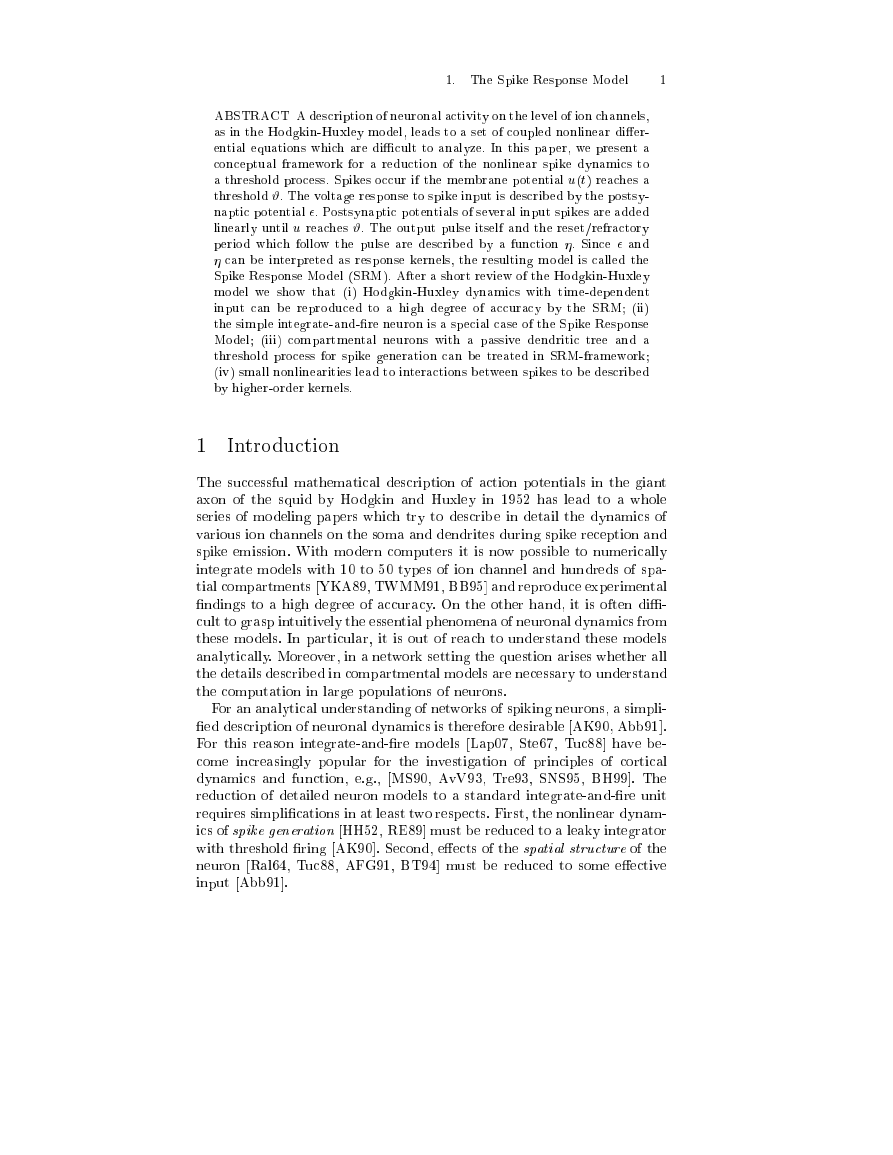
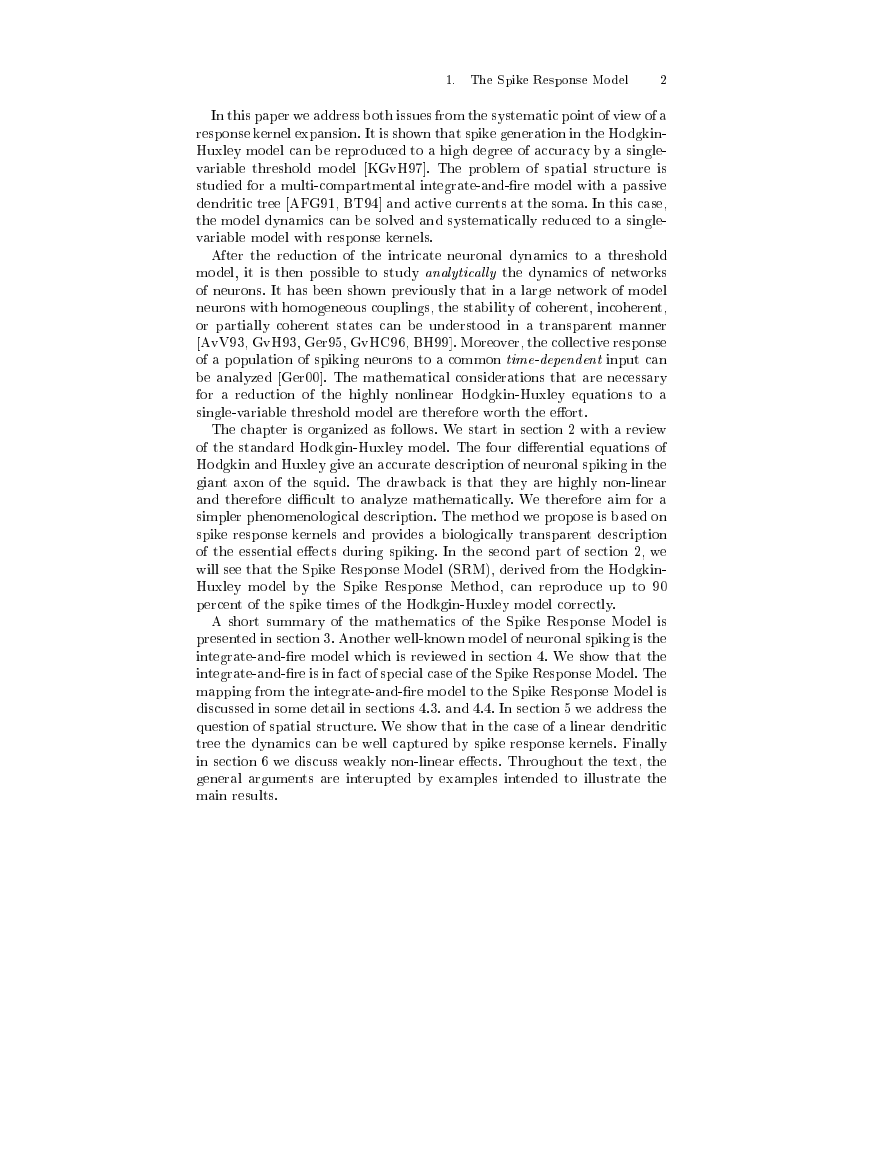
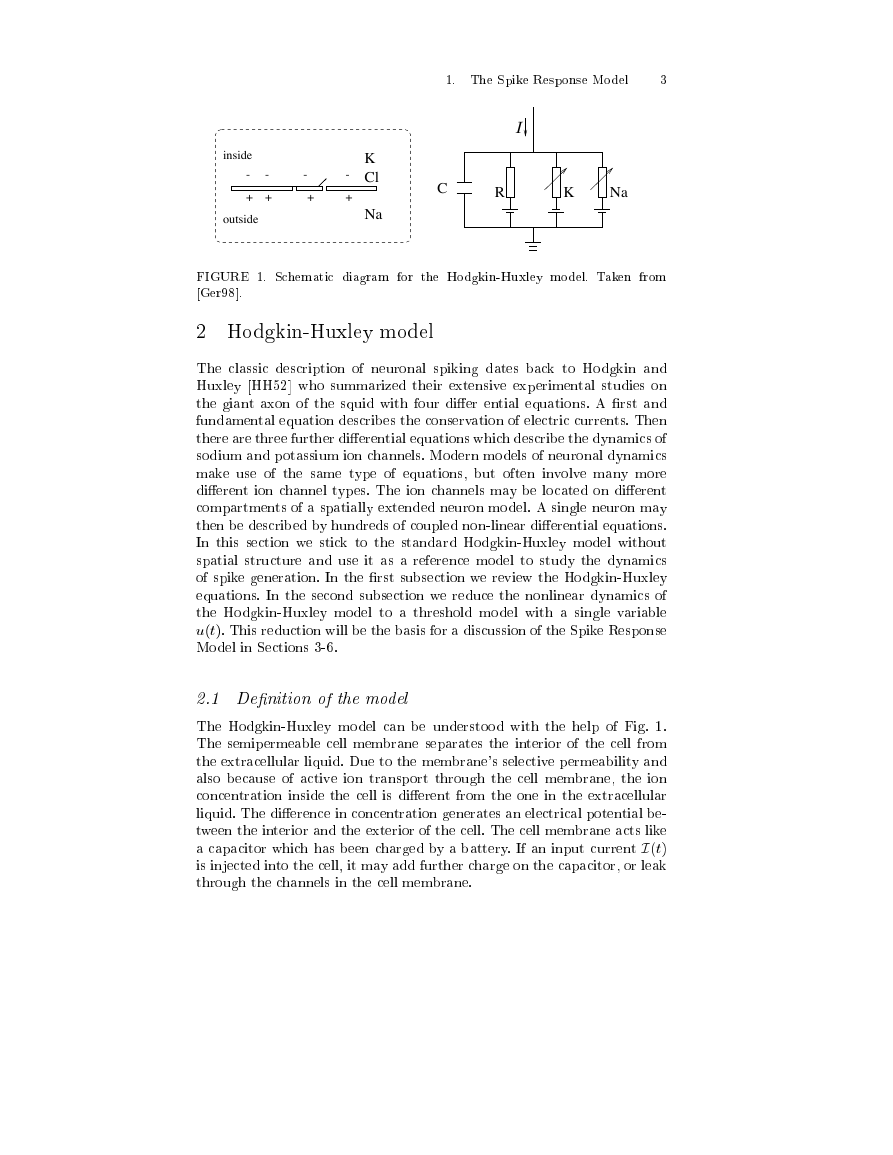
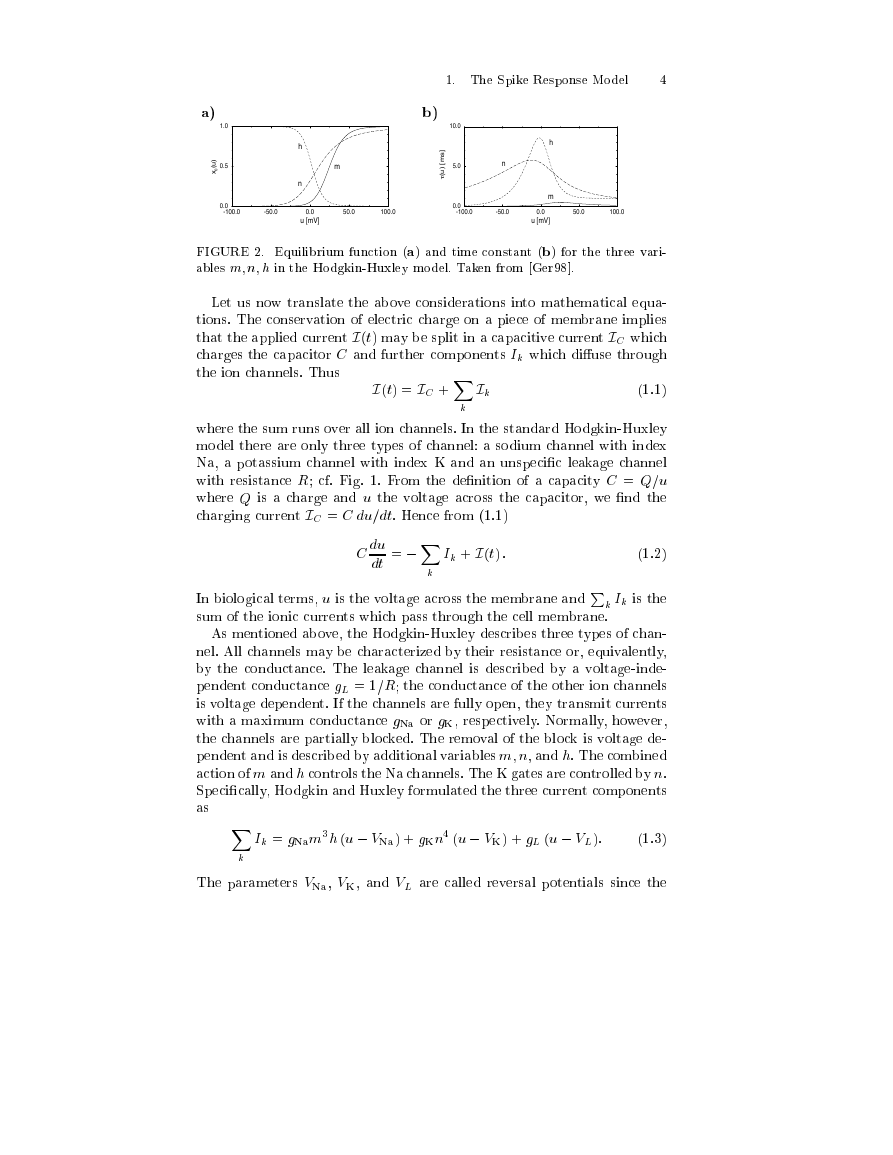
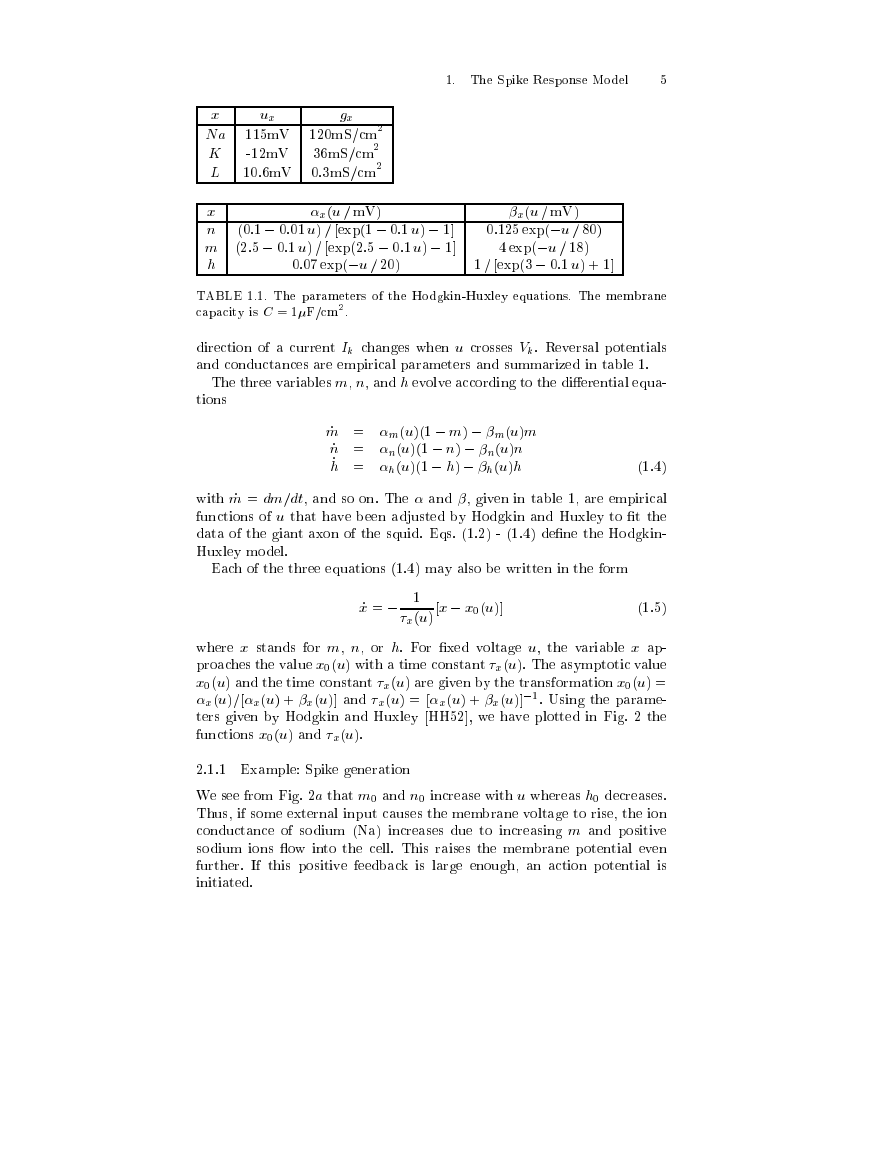
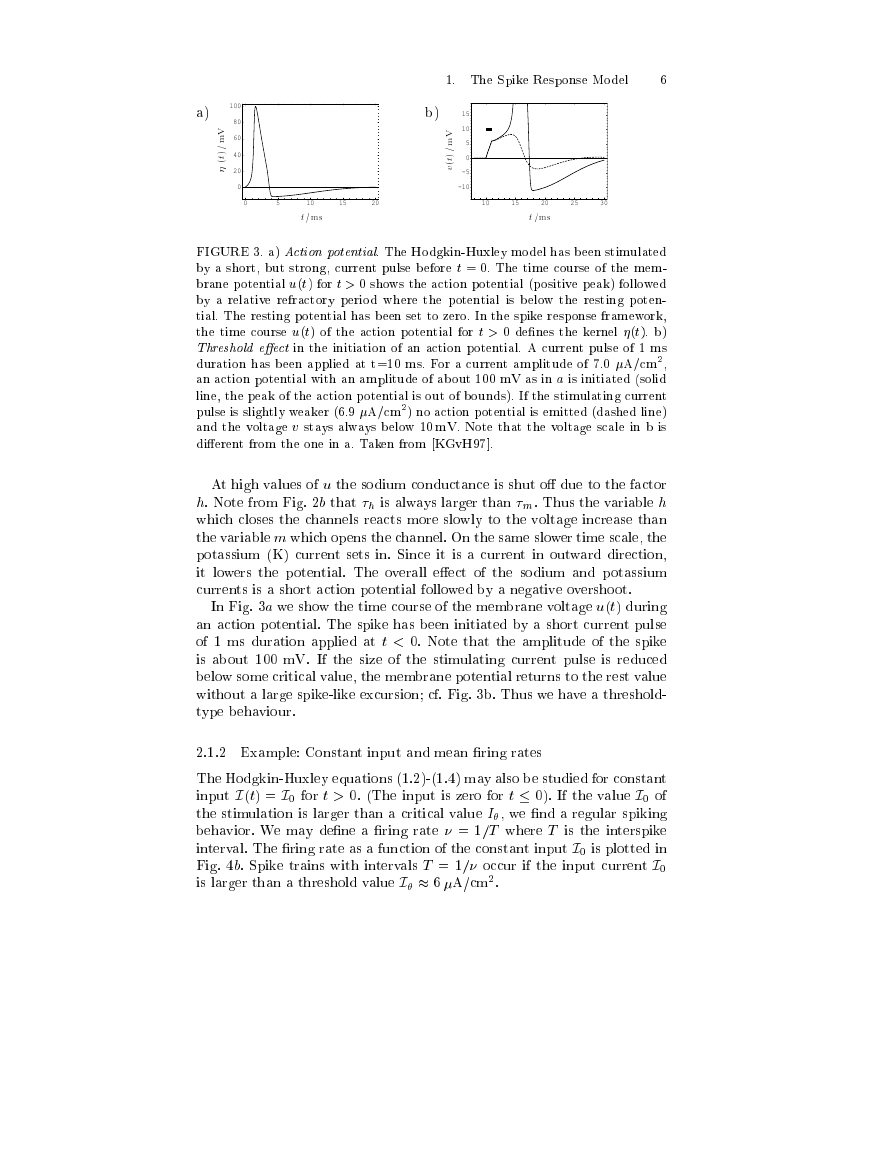








 2023年江西萍乡中考道德与法治真题及答案.doc
2023年江西萍乡中考道德与法治真题及答案.doc 2012年重庆南川中考生物真题及答案.doc
2012年重庆南川中考生物真题及答案.doc 2013年江西师范大学地理学综合及文艺理论基础考研真题.doc
2013年江西师范大学地理学综合及文艺理论基础考研真题.doc 2020年四川甘孜小升初语文真题及答案I卷.doc
2020年四川甘孜小升初语文真题及答案I卷.doc 2020年注册岩土工程师专业基础考试真题及答案.doc
2020年注册岩土工程师专业基础考试真题及答案.doc 2023-2024学年福建省厦门市九年级上学期数学月考试题及答案.doc
2023-2024学年福建省厦门市九年级上学期数学月考试题及答案.doc 2021-2022学年辽宁省沈阳市大东区九年级上学期语文期末试题及答案.doc
2021-2022学年辽宁省沈阳市大东区九年级上学期语文期末试题及答案.doc 2022-2023学年北京东城区初三第一学期物理期末试卷及答案.doc
2022-2023学年北京东城区初三第一学期物理期末试卷及答案.doc 2018上半年江西教师资格初中地理学科知识与教学能力真题及答案.doc
2018上半年江西教师资格初中地理学科知识与教学能力真题及答案.doc 2012年河北国家公务员申论考试真题及答案-省级.doc
2012年河北国家公务员申论考试真题及答案-省级.doc 2020-2021学年江苏省扬州市江都区邵樊片九年级上学期数学第一次质量检测试题及答案.doc
2020-2021学年江苏省扬州市江都区邵樊片九年级上学期数学第一次质量检测试题及答案.doc 2022下半年黑龙江教师资格证中学综合素质真题及答案.doc
2022下半年黑龙江教师资格证中学综合素质真题及答案.doc